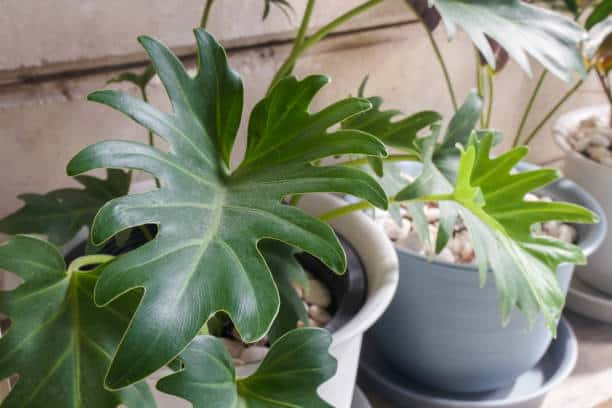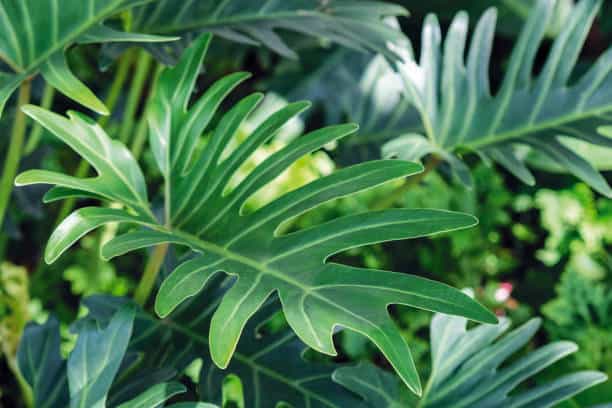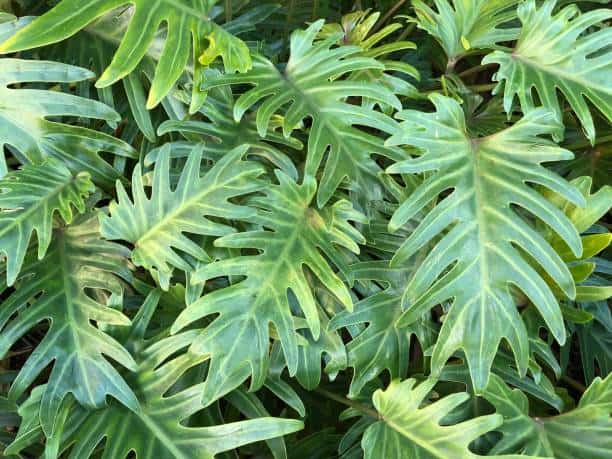
What Is Philodendron Xanadu?
Philodendron xanadu is a popular houseplant known for its striking foliage and easy-to-care-for nature. It is a member of the Araceae family, which also includes other popular indoor plants such as the peace lily and pothos.
The Philodendron xanadu is native to Brazil, and is named after the famous Xanadu estate owned by media mogul William Randolph Hearst. Its leaves are deeply lobed and glossy, with a lush, tropical appearance. The plant can grow up to 4 feet tall and wide, and its compact size makes it an ideal choice for small spaces.
One of the benefits of the Philodendron xanadu is that it is low-maintenance and can tolerate a range of lighting conditions. It prefers bright, indirect light but can also grow in lower light conditions, though growth may be slower. It also requires well-draining soil and only needs to be watered when the soil is dry to the touch.
Philodendron xanadu is also a great air-purifying plant, which means it can help remove toxins from the air. Its ease of care and attractive appearance make it a great choice for both experienced and novice plant enthusiasts alike.
Philodendron Xanadu Care & Maintenance:
Philodendron Xanadu Care is quite easy with frequent trimming of the parts that grow too long. It makes a perfect house plant as it does not require direct sunlight to thrive well. However, the indirect sun is preferable for its vibrant green leaves.
This plant requires very little maintenance apart from trimming off unwanted growth and pruning dead leaves. Trim off any dead or dying stems at stem joints using sharp scissors if you want to maintain them in a more bushy shape or allow them to grow longer for a trailing effect.
You can fertilize this plant by adding liquid fertilizer every 2 weeks during the spring and summer months and once a month in winter. Fertilizing your philodendron helps keep it healthy and it will grow better.
Size of Philodendron Xanadu:

A properly cared-for potted philodendron Xanadu will reach a height of up to 3 feet and a width of 1 foot.
It has a tendency to get leggy so try to find some kind of support for the heavy vines such as attaching them to rocks, driftwood, or other structures with fishing lines, coated thread, or any other suitable material.
When tied off, the leaves can be allowed to hang down thus giving it the appearance of being fuller than you would expect due to its large leaf size which is 6-8 inches long on average although they may vary in size depending on how much mature they are. This plant can also be propagated by leaf cuttings and will grow roots on its own.
A philodendron Xanadu plant is considered to be a hanging plant as the leaves at the top are very long. It can be kept indoors where it does not require any direct sunlight.
However, indirect sunlight is beneficial for it to thrive well. If you want this plant to have full-sized green leaves without having the plants that grow in low light conditions, then you should try growing them under fluorescent lights or some other kind of artificial lighting that has sufficient coverage over the entire surface area of your indoor garden in order to keep the entire plant happy and healthy.
Temperature:
Philodendron Xanadu can tolerate a wide range of temperatures, but it prefers a warm, humid environment. The ideal temperature range for Philodendron Xanadu is between 65-80°F (18-27°C). It can tolerate temperatures as low as 50°F (10°C) for short periods of time, but prolonged exposure to cooler temperatures can damage the leaves and slow growth.
It’s important to keep in mind that Philodendron Xanadu is a tropical plant, and it doesn’t tolerate cold drafts or sudden temperature changes. It’s best to keep it away from windows, doors, and air conditioning vents that may cause fluctuations in temperature.
During the winter months, it’s important to make sure the plant is not exposed to cold drafts or temperatures below 50°F (10°C). If you live in a colder climate, you may need to provide supplemental heat to keep the plant warm.
Overall, Philodendron Xanadu is a fairly tolerant plant when it comes to temperature, but it’s best to keep it in a warm, stable environment to promote healthy growth and prevent damage to the leaves.
Sunlight:

Philodendron Xanadu requires a moderate amount of sunlight to grow well. It can survive with low light, but it will keep its leaves small and cause the plant to be spindly and weak.
For the best health and growth, it is recommended that Philodendron Xanadu be placed in an area with 2-4 hours of direct sunlight.
These plants grow well under artificial lighting as well if you do not have strong enough natural light sources in your home or office. You should try to give your plants as much sun as possible while still keeping them safe from burning or scorching.
Water:
Philodendron Xanadu has moderate water requirements and prefers to be kept evenly moist but not waterlogged. Overwatering can lead to root rot and other problems, so it’s important to make sure the soil is not constantly wet.
Here are some tips for watering your Philodendron Xanadu:
- Check the soil: Before watering, check the soil to make sure it’s dry to the touch at a depth of about an inch (2.5 cm). If the soil is still moist, wait a few days before checking again.
- Water thoroughly: When you water, make sure to water thoroughly so that the water reaches the roots. Water until water starts to drain out of the bottom of the pot.
- Drainage: Make sure your pot has drainage holes to prevent water from sitting in the bottom of the pot. If your pot doesn’t have drainage holes, you can add a layer of gravel to the bottom to improve drainage.
- Frequency: The frequency of watering will depend on factors like temperature, humidity, and the size of the pot. In general, Philodendron Xanadu should be watered when the top inch (2.5 cm) of soil is dry to the touch. During the growing season, you may need to water more frequently than in the winter.
- Humidity: Philodendron Xanadu prefers higher humidity levels, so you may need to water more frequently if the air is dry. You can also increase humidity by misting the leaves with water or placing a tray of water near the plant.
- Adjust for the season: During the winter months, you may need to water less frequently to avoid overwatering. Make sure to adjust your watering schedule based on the conditions in your home.
Soil:

Philodendron Xanadu prefers more acidic soil with good drainage. They like to be kept in a humus-rich, well-draining potting mix and will adapt very quickly to new soils as long as they are not completely different than what has been mentioned above (i.e., bark instead of soil).
If you ever need to change the type of pots you are using, try mixing some sphagnum peat moss into your existing potting mix before planting it. This will help prepare your plant for the changes in its environment so it can adjust faster and thrive better.
plants’ roots reach deep down into the ground where nutrients lie, so if a plant has been transplanted from one place to another, it will take some time for the plant to adjust and thrive.
Fertilizer:
Philodendron Xanadu enjoys high potash and low phosphorus solution. We use an organic fertilizer such as Osmocote every 3-4 months.
You may also feed with any fish emulsion or would not do any harm to fertilize once a week with it either. If you have algae in your tank, we recommend feeding 1-2x per week during the summer. While the tank is being set up because this will give them extra nutrients they need to grow quickly while competing with algae for available nutrients.
In our experience, both selaginellas and java ferns seem to love higher nitrate than the other plants in a tank. Once your tank is established, you can decrease the nitrates to lower levels by removing fish or doing partial water changes.
Planting:
The best way to plant is just to push them into the gravel at an angle until they are about 2/3 covered with soil and then use your hand to cover the rest of the cutting with soil as it will settle on its own as it establishes itself.
The easiest method is to stab them into the substrate about 1″ below (or above) where you would like the plant to be located and then bury it with either dry rock/gravel, sand from an established system, purchased activated carbon, or a mix of all 3 for added stability.
A layer of sand, gravel, or masonry sand can be added for support if the selaginella is to be placed on “rocks”.
Propagation:

Selaginella propagation is done by taking leaf cuttings. The best times of year are in late summer and early fall when they will need several hours of darkness per day (10-12hrs) and temperatures between 18-23? C / 65-75*.
Philodendron xanadu can be easily propagated through stem cuttings, division, or air layering. Here are some tips for propagating your Philodendron xanadu:
- Stem cuttings: Take a stem cutting from the plant that is at least 4 inches (10 cm) long with a few leaves. Remove the lower leaves from the stem, leaving only a few at the top. Place the stem cutting in a pot filled with moist potting soil and water well. Cover the pot with a plastic bag or wrap to increase humidity and place it in a bright, indirect light. The cutting should root within a few weeks.
- Division: If your Philodendron xanadu has outgrown its pot, you can divide it into smaller plants. Carefully remove the plant from the pot and gently separate the root ball into smaller sections. Each section should have a few leaves and some roots. Replant each section into its own pot with fresh potting soil and water well.
- Air layering: Air layering is a method of propagating plants by creating roots on a stem that is still attached to the parent plant. To air layer a Philodendron xanadu, choose a stem that is at least 1/4 inch (0.6 cm) thick and make a small cut in the bark about 1 inch (2.5 cm) below a node. Wrap the cut area with damp sphagnum moss and cover it with plastic wrap to hold the moisture in. After a few weeks, roots should start to grow from the cut area. Once the roots are well-developed, cut the stem below the roots and plant it in a pot with fresh potting soil.
Propagation is a great way to create new plants and expand your collection of Philodendron xanadu. With these tips, you can successfully propagate your plant and share it with others.
Conclusion
In conclusion, Philodendron Xanadu is a popular and easy-to-care-for houseplant that is known for its attractive foliage and tropical appearance. It is a member of the Araceae family, which includes other popular indoor plants like the peace lily and pothos.
To care for your Philodendron Xanadu, it’s important to provide it with the right growing conditions. This includes bright, indirect light, moderate watering, and higher humidity levels. Philodendron Xanadu prefers a warm, stable environment with temperatures between 65-80°F (18-27°C), and it’s important to avoid exposing it to cold drafts or sudden temperature changes.
Overall, Philodendron Xanadu is a great choice for both experienced and novice plant enthusiasts alike. With the right care and attention, it can thrive and add a touch of tropical beauty to any indoor space.










